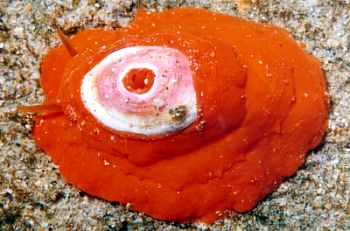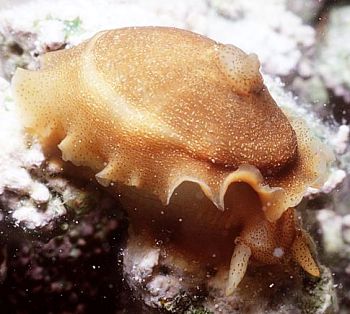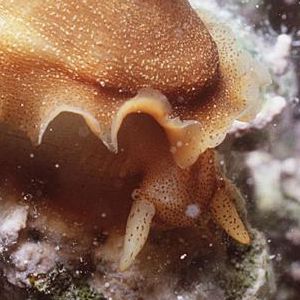
Key Hole Limpets
Order: VETIGASTROPODA
Superfamily: FISSURELLOIDEA
Family: Fissurellidae
PHOTO
Cosmetalepas africana. Eastern Cape, South Africa, 18m, July 2000. 5cm long. Photo: Valda Fraser
The fissurellids are a family of marine snails with cap-like or limpet-like shells which sit on the back of the snail and are often partly, or completely covered, by flaps of skin. The shell often has a slit, or in the case of the Key Hole Limpets a central hole to accommodate a mantle siphon. Another example of this family are the Elephant Slugs Scutus. They are not sea slugs, but are often mistaken for slugs.
Authorship detailsRudman, W.B., 2001 (May 24) Key Hole Limpets. [In] Sea Slug Forum. Australian Museum, Sydney. Available from http://www.seaslugforum.net/find/keyhole
Related messages
Limpet? from the Bahamas
June 25, 2001
From: Anne DuPont

Hi Bill,
I have just returned from 2 months in the Bahamas, and on a night dive I found this little critter in about 6 feet of water. It was crawling on dead coral near some bright orange encrusting sponge about the same color as the critter. It was about 1 inch long and from the hole on top it was shooting out "a white smokey substance" I found another one on the orange sponge.
Is this a limpet?
Thank you again for your time.
Best regards,
Anne DuPont
Delray Beach, Fl
adupont@gate.net
DuPont, A., 2001 (Jun 25) Limpet? from the Bahamas. [Message in] Sea Slug Forum. Australian Museum, Sydney. Available from http://www.seaslugforum.net/find/4654
Dear Anne,
Yes this is a 'limpet' - in fact a Keyhole Limpet, so named because its shell has a hole in the apex of the shell through which the siphon to the mantle cavity can communicate with the outside world. They are quite closely related to that other 'sluggy' snail, Scutus which has generated quite a few queries.
The white smoky substance you observed is a secretion from the Hypobranchial Gland, which is found by the gill, in the mantle cavity of many snails. The purpose of the secretions is still not really understood. One snippet of interesting information concerning the hypobranchial gland is that the reddish dye called Tyrian Purple which was used to die the clothes of important people in ancient times, was obtained from the hypobranchial gland of muricid snails (Murex, Thais spp). It was first made in Tyre in the eastern Mediterranean 2-3000 years ago in what was probably one of the earliest chemical industries. The purple ink produced by Sea Hares, which is also reddish, is quite different and not permanent.
In your photo you can see the snail-like head with the eye embedded in the skin at the base of the head tentacle. The shell is completely covered by a flap of skin, but the ridge running around the body indicates the edge of the shell.
Best wishes,
Bill Rudman
Keyhole limpet from South Africa
May 30, 2001
From: Valda Fraser

Dear Bill
The best I can do is... keyhole limpet. Please give me its real name. Thanks.
Locality: Brazen Head, Eastern Cape, SOUTH AFRICA, 18m
Date: July 2000
Size: 5cm
Regards
Valda Fraser
valdafraser@mweb.co.za
Fraser, V., 2001 (May 30) Keyhole limpet from South Africa. [Message in] Sea Slug Forum. Australian Museum, Sydney. Available from http://www.seaslugforum.net/find/4365Dear Valda,
I usually decline to answer snail questions but I guess a keyhole limpet could be mistaken for a slug, and it is related to Scutus which is definitely slug-like. I am not an expert on fissurellids, and definitely not South African ones but I think this is Cosmetalepas africana (Tomlin, 1926) -[Family Fissurellidae]. It is relatively common in southern African waters from Cape Agulhas to Zululand but normally found as a beached shell. The living animal has rarely been seen. It ranges in colour from cream to orange sometimes with black speckling. It is a subtidal species found from 10 - 100m, and feeds on sponges. Dr Dai Herbert at the Natal Museum may be interested in a copy of your photo.
• Herbert, D.G. (1988) Observations on the southern African fissurellids Cosmetalepas africana and Macroschisma africana (Mollusca: Gastropoda: Fissurellidae). Annals of the Natal Museum, 29(2): 491-501
Best wishes,
Bill Rudman
